Detection of Solar Photovoltaic Power Plants Using Satellite and Airborne Hyperspectral Imaging
Abstract
1. Introduction
- Spaceborne HSI data acquired by the Hyperspectral Precursor of the Application Mission (PRISMA) satellite with 30 m resolution
- Airborne HSI data acquired by the Airborne Visible InfraRed Imaging Spectrometer–Next Generation (AVIRIS-NG) with 5.3 m resolution
- Focus on solar PV plants with more than 10 kWp
2. Materials and Methods
2.1. Study Area
2.2. AVIRIS-NG Data and Preprocessing
2.3. PRISMA Data and Preprocessing
2.4. PV Ground Truth Data
2.5. Indices
2.5.1. Normalized Hydrocarbon Index (nHI)
2.5.2. Normalized Solar Panel Index (NSPI)
2.5.3. Index of Average Reflectance in VNIR (aVNIR)
2.5.4. PolyEthylene Peak (PEP) and PolyEthylene Peak in Visible Range (VPEP)
2.6. Accuracy Metrics
2.7. Threshold Classification Model & Hyperparameter Optimization
3. Results
3.1. Solar PV Detection Using AVIRIS-NG
3.2. Solar PV Detection Using PRISMA
3.3. Qualitative Spectral Characteristics
4. Discussion
5. Conclusions
Author Contributions
Funding
Data Availability Statement
Acknowledgments
Conflicts of Interest
Abbreviations
| ASI | Agenzia Spaziale Italiana |
| AVIRIS-NG | Airborne Visible InfraRed Imaging Spectrometer-Next Generation |
| aVNIR | Index of average reflectance in VNIR |
| CHIME | Copernicus Hyperspectral Imaging Mission for the Environment mission |
| EnMAP | Environmental Mapping and Analysis Program |
| ESA | European Space Agency |
| EVA | Ethylene Vinyl Acetate |
| HI | Hydrocarbon Index |
| nHI | Normalized Hydrocarbon Index |
| NSPI | Normalized Solar Panel Index |
| PRISMA | Hyperspectral Precursor of the Application Mission |
| PV | photovoltaic |
| SDGs | Sustainable Development Goals |
| VIS | visible light range |
References
- International Energy Agency. Renewables 2019. Analysis and Forecast to 2024. Available online: https://www.iea.org/reports/renewables-2019 (accessed on 10 December 2022).
- Xia, Z.; Li, Y.; Chen, R.; Sengupta, D.; Guo, X.; Xiong, B.; Niu, Y. Mapping the rapid development of photovoltaic power stations in northwestern China using remote sensing. Energy Rep. 2022, 8, 4117–4127. [Google Scholar] [CrossRef]
- Ji, C.; Bachmann, M.; Esch, T.; Feilhauer, H.; Heiden, U.; Heldens, W.; Hueni, A.; Lakes, T.; Metz-Marconcini, A.; Schroedter-Homscheidt, M.; et al. Solar photovoltaic module detection using laboratory and airborne imaging spectroscopy data. Remote Sens. Environ. 2021, 266, 112692. [Google Scholar] [CrossRef]
- Malof, J.M.; Bradbury, K.; Collins, L.M.; Newell, R.G. Automatic detection of solar photovoltaic arrays in high resolution aerial imagery. Appl. Energy 2016, 183, 229–240. [Google Scholar] [CrossRef]
- Wang, J.; Liu, J.; Li, L. Detecting Photovoltaic Installations in Diverse Landscapes Using Open Multi-Source Remote Sensing Data. Remote Sens. 2022, 14, 6296. [Google Scholar] [CrossRef]
- Dunnett, S.; Sorichetta, A.; Taylor, G.; Eigenbrod, F. Harmonised global datasets of wind and solar farm locations and power. Sci. Data 2020, 7, 130. [Google Scholar] [CrossRef] [PubMed]
- Hernandez, R.; Easter, S.; Murphy-Mariscal, M.; Maestre, F.; Tavassoli, M.; Allen, E.; Barrows, C.; Belnap, J.; Ochoa-Hueso, R.; Ravi, S.; et al. Environmental impacts of utility-scale solar energy. Renew. Sustain. Energy Rev. 2014, 29, 766–779. [Google Scholar] [CrossRef]
- Wu, A.N.; Biljecki, F. Roofpedia: Automatic mapping of green and solar roofs for an open roofscape registry and evaluation of urban sustainability. Landsc. Urban Plan. 2021, 214, 104167. [Google Scholar] [CrossRef]
- Ge, F.; Wang, G.; He, G.; Zhou, D.; Yin, R.; Tong, L. A Hierarchical Information Extraction Method for Large-Scale Centralized Photovoltaic Power Plants Based on Multi-Source Remote Sensing Images. Remote Sens. 2022, 14, 4211. [Google Scholar] [CrossRef]
- Evans, J.; Kiesecker, J. Shale Gas, Wind and Water: Assessing the Potential Cumulative Impacts of Energy Development on Ecosystem Services within the Marcellus Play. PLoS ONE 2014, 9, e89210. [Google Scholar] [CrossRef]
- Yu, J.; Wang, Z.; Majumdar, A.; Rajagopal, R. DeepSolar: A Machine Learning Framework to Efficiently Construct a Solar Deployment Database in the United States. Joule 2018, 2, 2605–2617. [Google Scholar] [CrossRef]
- Bundesnetzagentur. Daten und Fakten zum Marktstammdatenregister. 2020. Available online: https://www.bundesnetzagentur.de/SharedDocs/Downloads/DE/Sachgebiete/Energie/Unternehmen_Institutionen/DatenaustauschUndMonitoring/MaStR/Factsheet.pdf?__blob=publicationFile&v=1 (accessed on 24 November 2022).
- EnMaP. EnMAP Images from the Lower Lausitz-An East-German Region in Transition. Available online: https://www.enmap.org/news/2022-10-19/ (accessed on 21 November 2022).
- de Hoog, J.; Maetschke, S.; Ilfrich, P.; Kolluri, R.R. Using Satellite and Aerial Imagery for Identification of Solar PV: State of the Art and Research Opportunities. In Proceedings of the Proceedings of the Eleventh ACM International Conference on Future Energy Systems, Virtual Event Australia, 22–26 June 2020; pp. 308–313. [CrossRef]
- Green, R.O.; Eastwood, M.L.; Sarture, C.M.; Chrien, T.G.; Aronsson, M.; Chippendale, B.J.; Faust, J.A.; Pavri, B.E.; Chovit, C.J.; Solis, M.; et al. Imaging Spectroscopy and the Airborne Visible/Infrared Imaging Spectrometer (AVIRIS). Remote Sens. Environ. 1998, 65, 227–248. [Google Scholar] [CrossRef]
- Heiden, U.; Segl, K.; Roessner, S.; Kaufmann, H. Determination of robust spectral features for identification of urban surface materials in hyperspectral remote sensing data. Remote Sens. Environ. 2007, 111, 537–552. [Google Scholar] [CrossRef]
- Bach, H. Die Bestimmung Hydrologischer und Landwirtschaftlicher Oberflächenparameter aus Hyperspektralen Fernerkundungsdaten; Münchener Universitätsschriften/Fakultät für Geowissenschaften/Münchener geographische Abhandlungen; Geobuch-Verlag: Munich, Germany, 1995; ISBN 978-3-925308-81-9. [Google Scholar]
- Czirjak, D.W. Detecting photovoltaic solar panels using hyperspectral imagery and estimating solar power production. J. Appl. Remote Sens. 2017, 11, 026007. [Google Scholar] [CrossRef]
- Bhattacharya, B.K.; Green, R.O.; Rao, S.; Saxena, M.; Sharma, S.; Ajay Kumar, K.; Srinivasulu, P.; Sharma, S.; Dhar, D.; Bandyopadhyay, S.; et al. An Overview of AVIRIS-NG Airborne Hyperspectral Science Campaign Over India. Curr. Sci. 2019, 116, 1082. [Google Scholar] [CrossRef]
- Somers, B.; Asner, G.P.; Tits, L.; Coppin, P. Endmember variability in Spectral Mixture Analysis: A review. Remote Sens. Environ. 2011, 115, 1603–1616. [Google Scholar] [CrossRef]
- Zhang, J.; Rivard, B.; Sánchez-Azofeifa, A.; Castro-Esau, K. Intra- and inter-class spectral variability of tropical tree species at La Selva, Costa Rica: Implications for species identification using HYDICE imagery. Remote Sens. Environ. 2006, 105, 129–141. [Google Scholar] [CrossRef]
- Karoui, M.; Benhalouche, F.; Deville, Y.; Djerriri, K.; Briottet, X.; Houet, T.; Le Bris, A.; Weber, C. Partial Linear NMF-Based Unmixing Methods for Detection and Area Estimation of Photovoltaic Panels in Urban Hyperspectral Remote Sensing Data. Remote Sens. 2019, 11, 2164. [Google Scholar] [CrossRef]
- Chen, Z.; Kang, Y.; Sun, Z.; Wu, F.; Zhang, Q. Extraction of Photovoltaic Plants Using Machine Learning Methods: A Case Study of the Pilot Energy City of Golmud, China. Remote Sens. 2022, 14, 2697. [Google Scholar] [CrossRef]
- Karoui, M.S.; Benhalouche, F.z.; Deville, Y.; Djerriri, K.; Briottet, X.; Bris, A.L. Detection And Area Estimation For Photovoltaic Panels In Urban Hyperspectral Remote Sensing Data By An Original Nmf-Based Unmixing Method. In Proceedings of the IGARSS 2018-2018 IEEE International Geoscience and Remote Sensing Symposium, Valencia, Spain, 22–27 July 2018; pp. 1640–1643. [Google Scholar] [CrossRef]
- Wocher, M.; Berger, K.; Verrelst, J.; Hank, T. Retrieval of carbon content and biomass from hyperspectral imagery over cultivated areas. ISPRS J. Photogramm. Remote Sens. 2022, 193, 104–114. [Google Scholar] [CrossRef]
- JPL, E. AVIRIS-Next Generation. Data-New Data Aquisitions. Available online: https://avirisng.jpl.nasa.gov/newdata.html (accessed on 18 November 2022).
- Chapman, J.W.; Thompson, D.R.; Helmlinger, M.C.; Bue, B.D.; Green, R.O.; Eastwood, M.L.; Geier, S.; Olson-Duvall, W.; Lundeen, S.R. Spectral and Radiometric Calibration of the Next Generation Airborne Visible Infrared Spectrometer (AVIRIS-NG). Remote Sens. 2019, 11, 2129. [Google Scholar] [CrossRef]
- Thompson, D.R.; Guanter, L.; Berk, A.; Gao, B.C.; Richter, R.; Schläpfer, D.; Thome, K.J. Retrieval of Atmospheric Parameters and Surface Reflectance from Visible and Shortwave Infrared Imaging Spectroscopy Data. Surv. Geophys. 2019, 40, 333–360. [Google Scholar] [CrossRef]
- ASI (Ed.) PRISMA Product Specification Document Issue 2.3 Date 12/03/2020; ASI: Feasterville-Trevose, PA, USA, 2020; Available online: http://prisma.asi.it/missionselect/docs/PRISMA%20Product%20Specifications_Is2_3.pdf (accessed on 20 November 2022).
- Baiocchi, V.; Giannone, F.; Monti, F. How to Orient and Orthorectify PRISMA Images and Related Issues. Remote Sens. 2022, 14, 1991. [Google Scholar] [CrossRef]
- Doormann, G. SolaranlagenPortal. Leistung von Photovoltaikanlagen. 2023. Available online: https://www.solaranlagen-portal.com/photovoltaik/leistung (accessed on 10 April 2023).
- Kühn, F.; Oppermann, K.; Hörig, B. Hydrocarbon Index—An algorithm for hyperspectral detection of hydrocarbons. Int. J. Remote Sens. 2004, 25, 2467–2473. [Google Scholar] [CrossRef]
- Cloutis, E.A. Spectral Reflectance Properties of Hydrocarbons: Remote-Sensing Implications. Science 1989, 245, 165–168. [Google Scholar] [CrossRef]
- Clark, R.N.; Roush, T.L. Reflectance spectroscopy: Quantitative analysis techniques for remotesensing applications. J. Geophys. Res. Solid Earth 1984, 89, 6329–6340. [Google Scholar] [CrossRef]
- Silvestre, S.; Tahri, A.; Tahri, F.; Benlebna, S.; Chouder, A. Evaluation of the performance and degradation of crystalline silicon-based photovoltaic modules in the Saharan environment. Energy 2018, 152, 57–63. [Google Scholar] [CrossRef]
- Schinke, C.; Christian Peest, P.; Schmidt, J.; Brendel, R.; Bothe, K.; Vogt, M.R.; Kröger, I.; Winter, S.; Schirmacher, A.; Lim, S.; et al. Uncertainty analysis for the coefficient of band-to-band absorption of crystalline silicon. AIP Adv. 2015, 5, 067168. [Google Scholar] [CrossRef]
- Deng, Q.; Wang, Z.; Wang, S.; Shao, G. Simulation of planar Si/Mg 2 Si/Si p-i-n heterojunction solar cells for high efficiency. Sol. Energy 2017, 158, 654–662. [Google Scholar] [CrossRef]

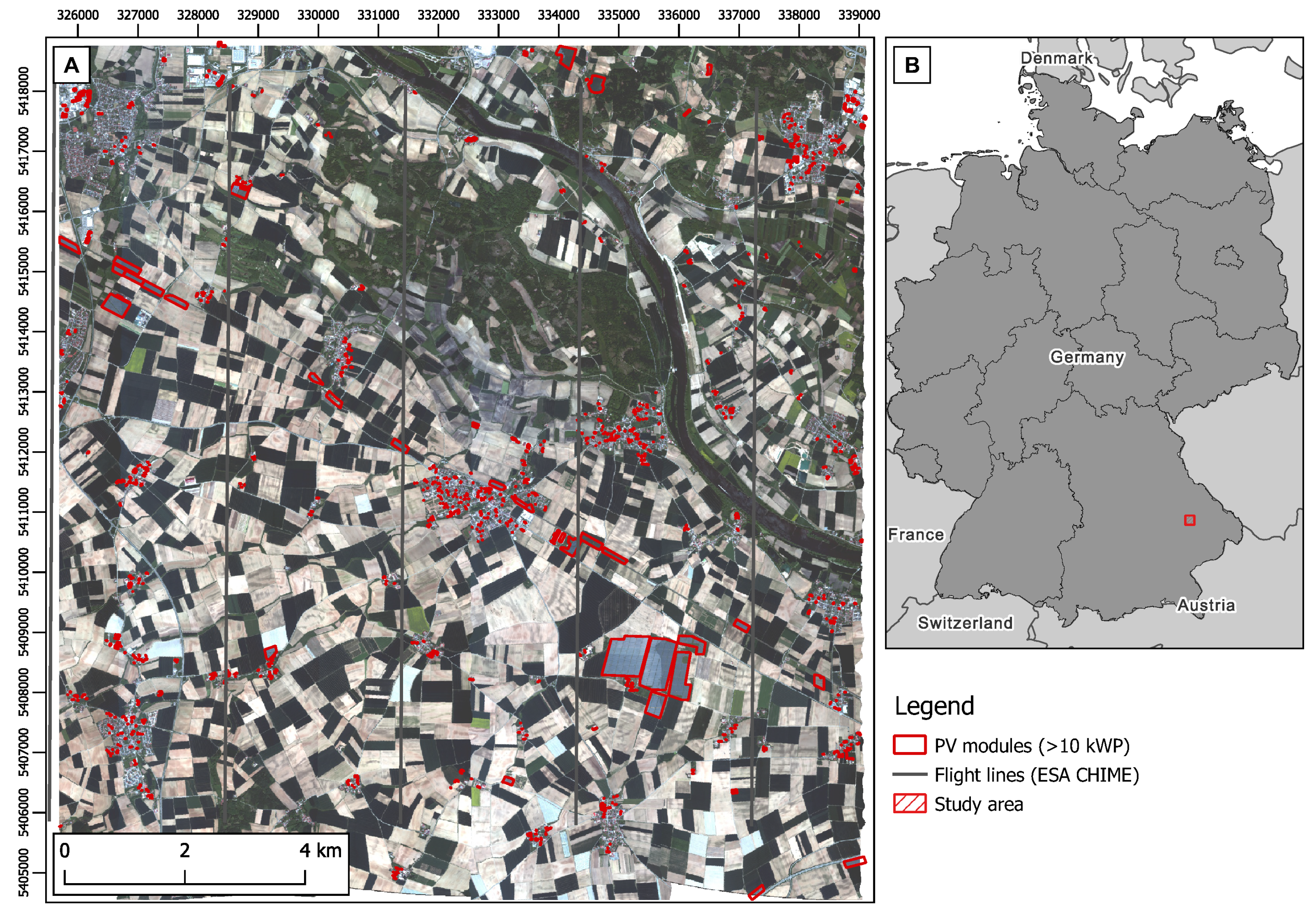

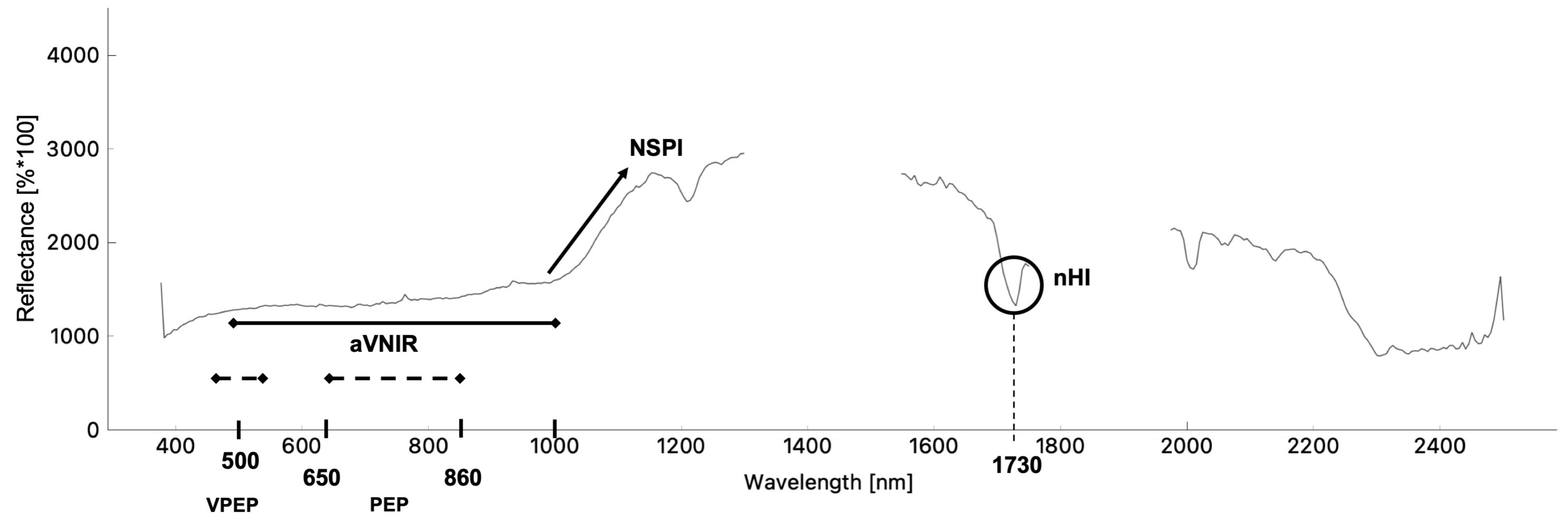
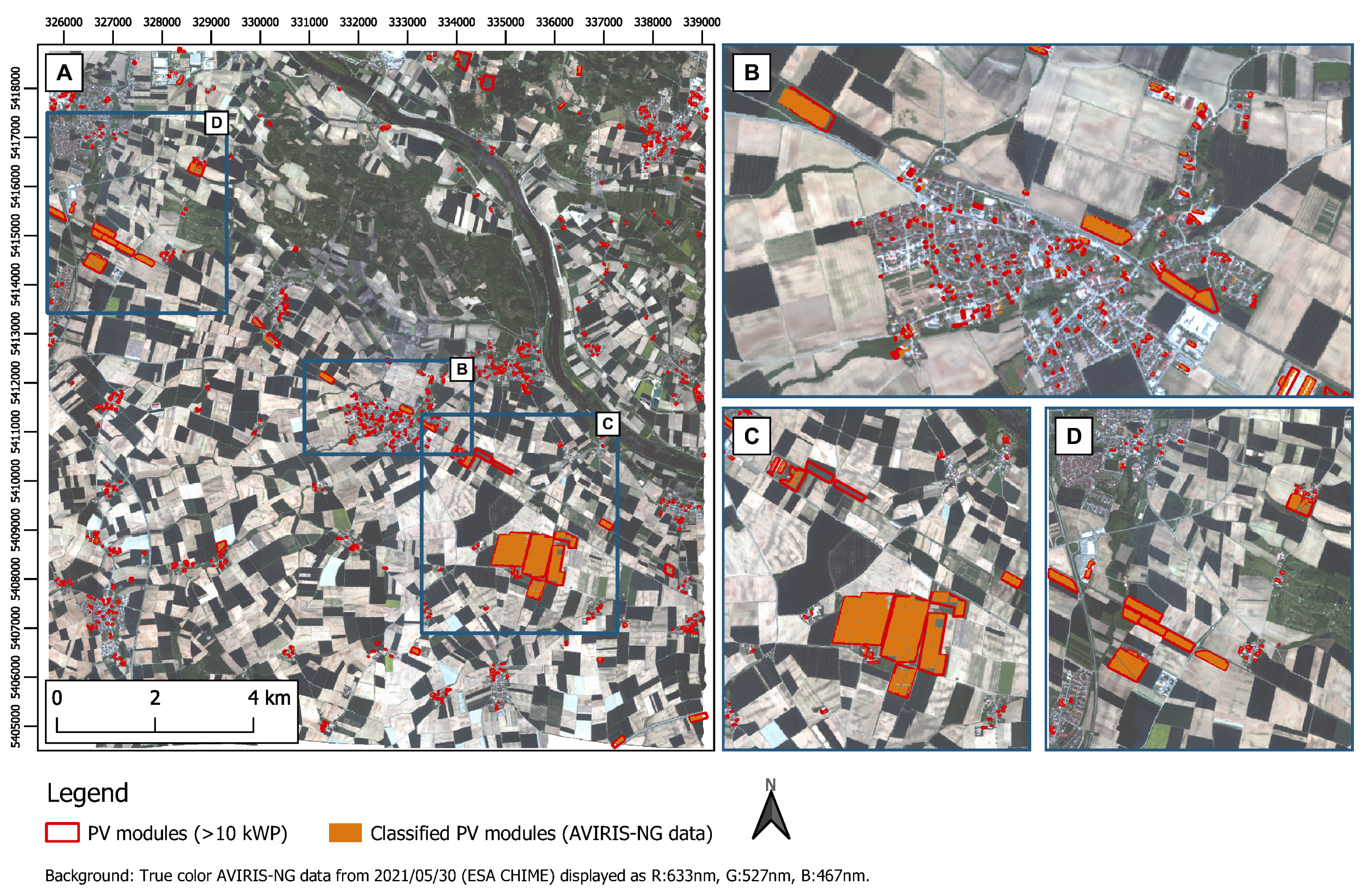
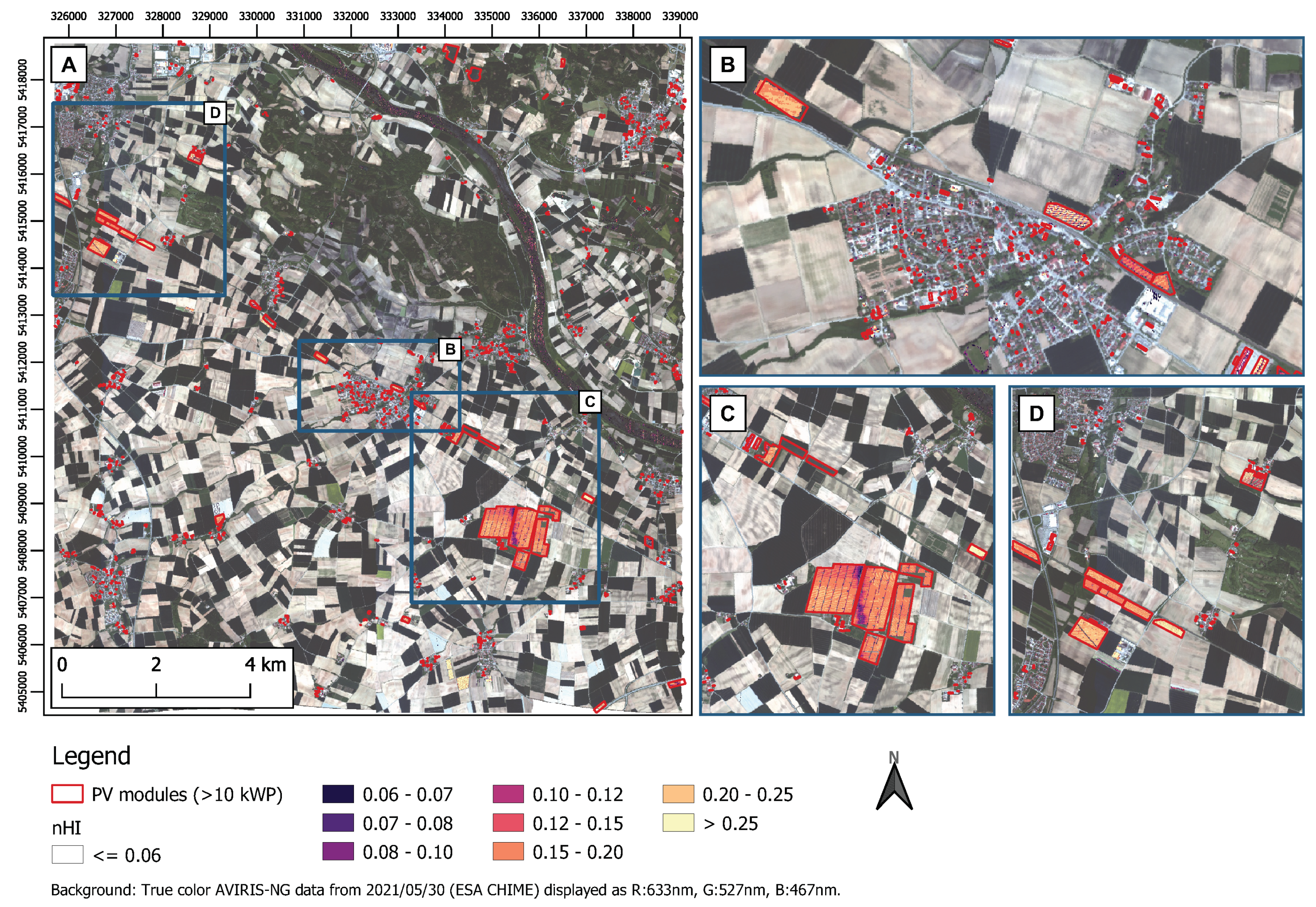
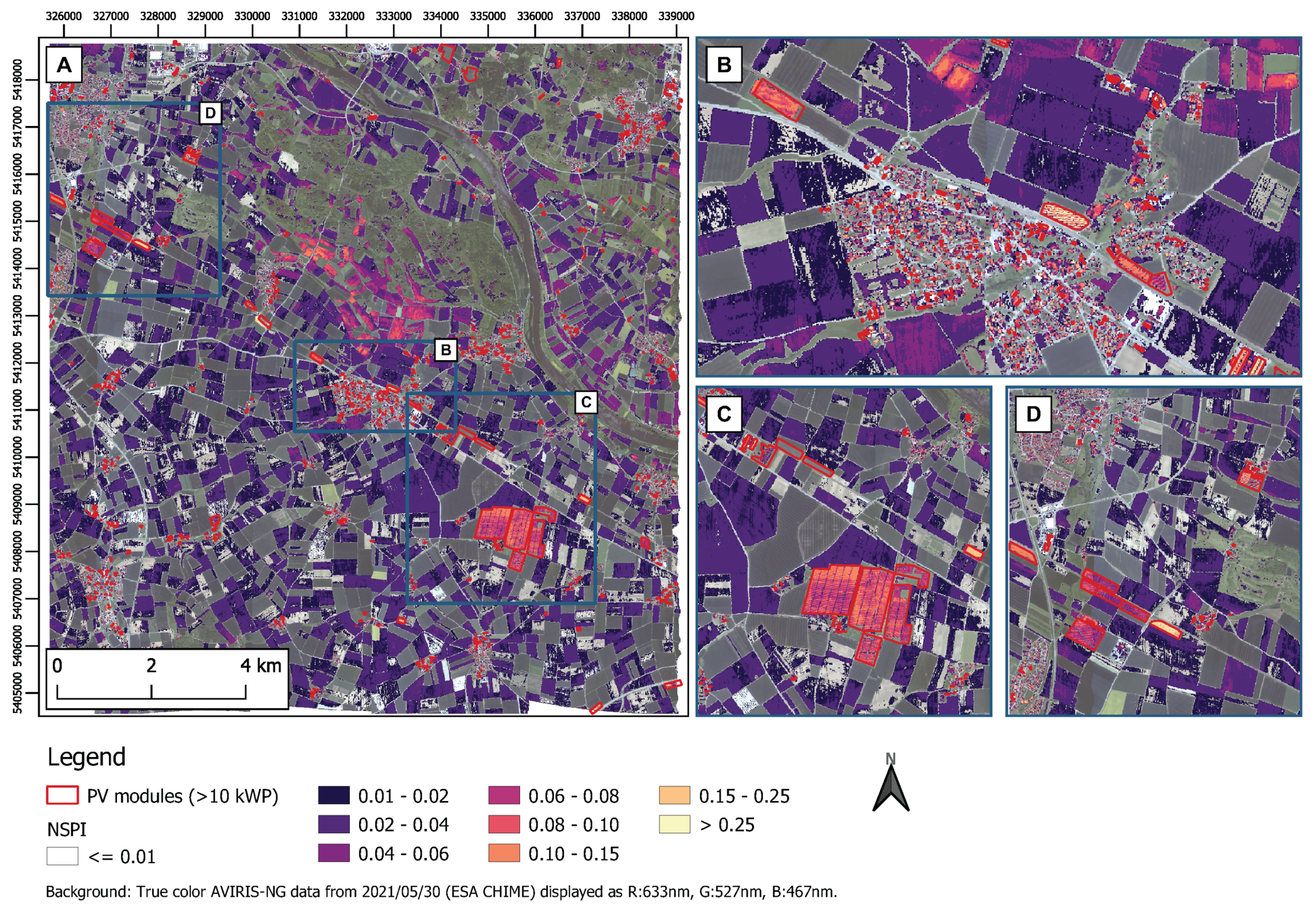
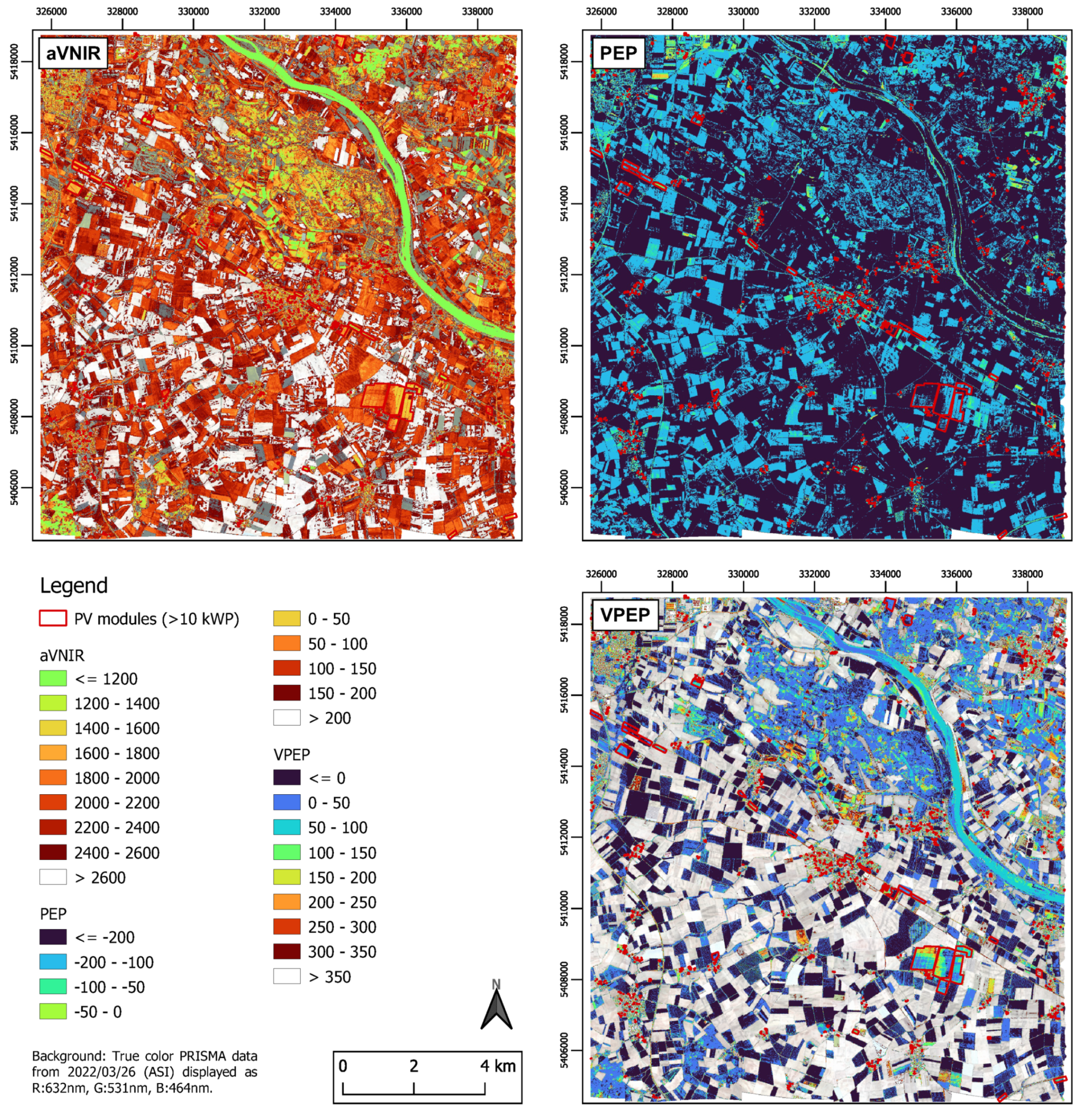
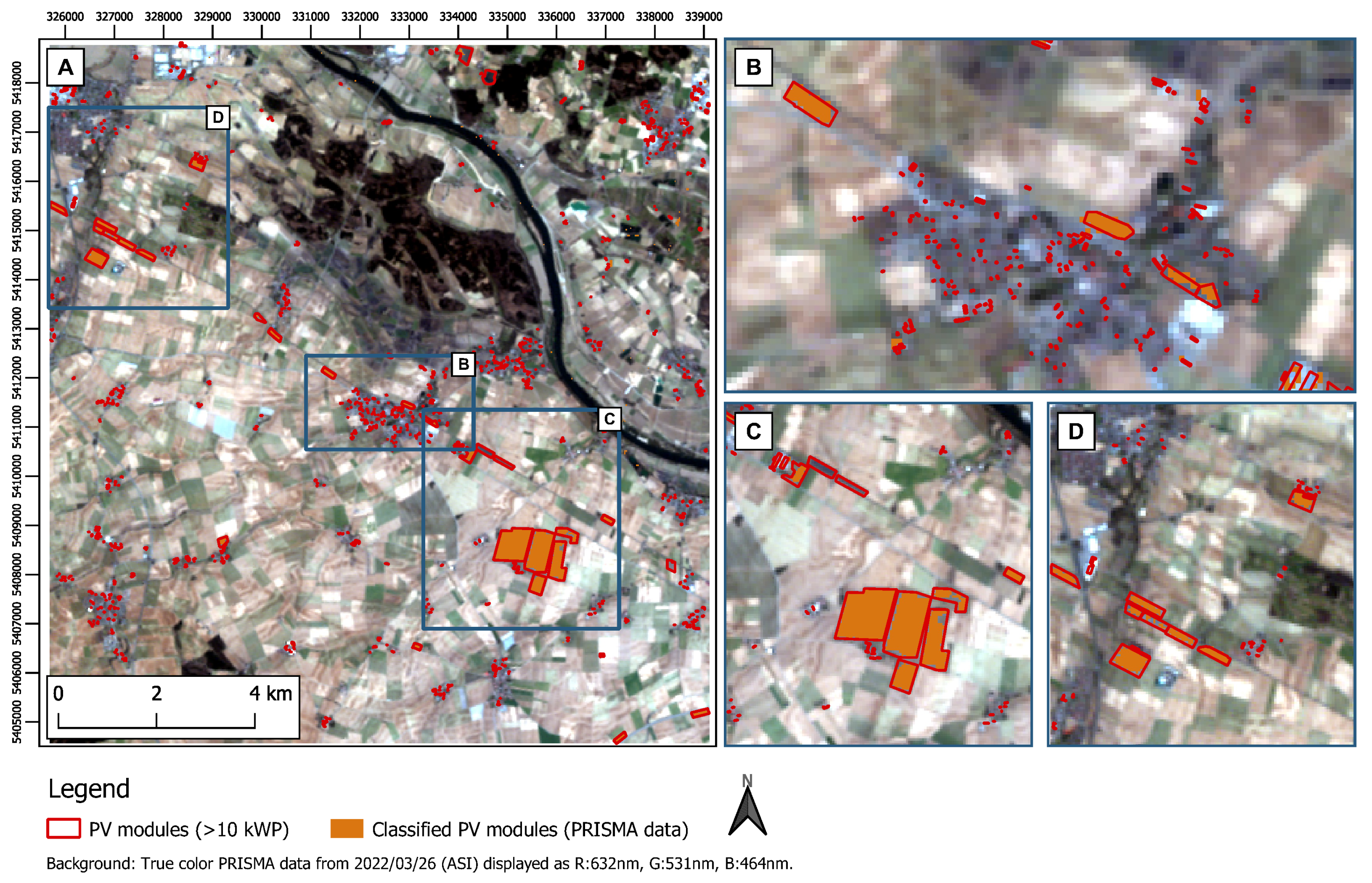
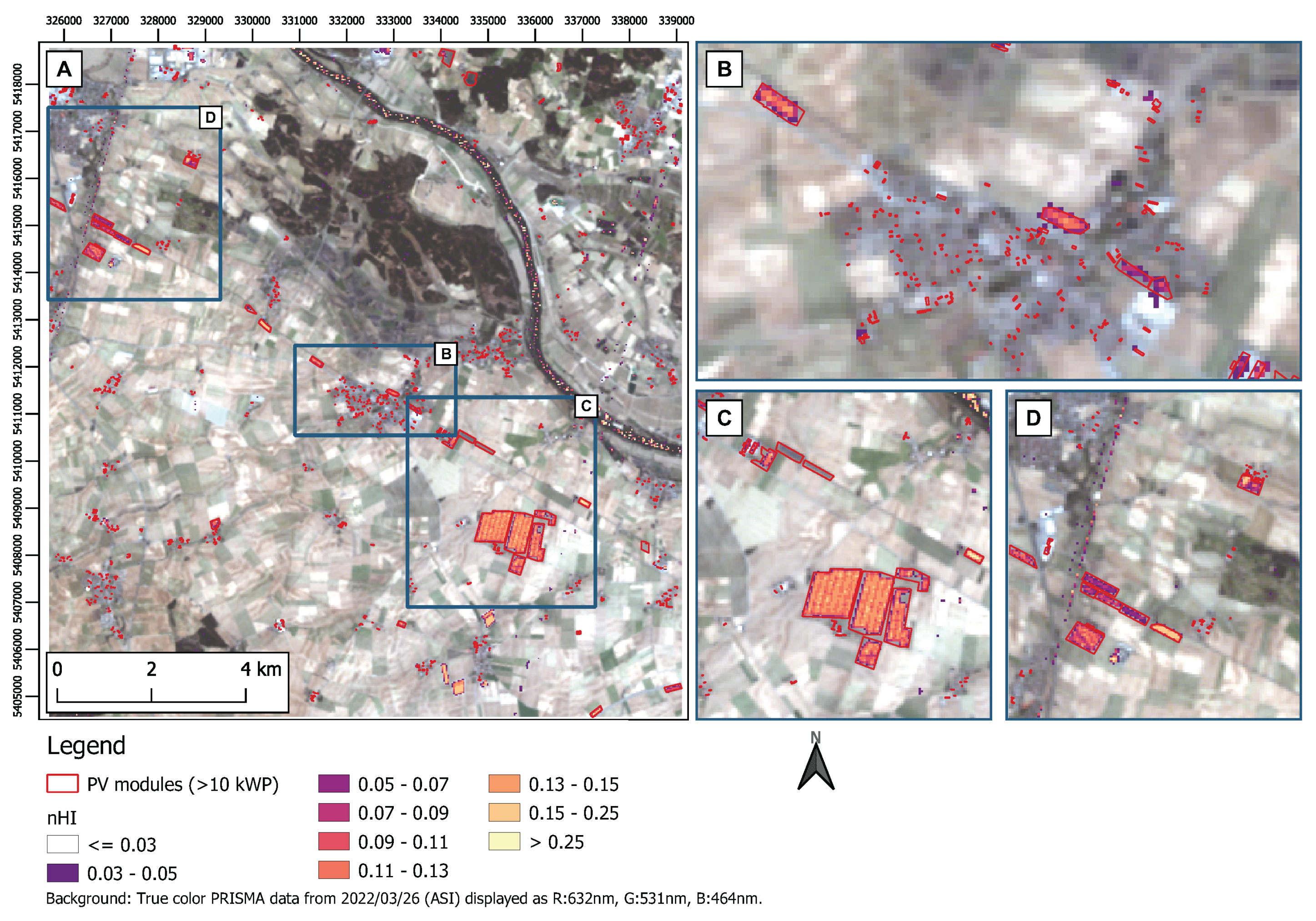
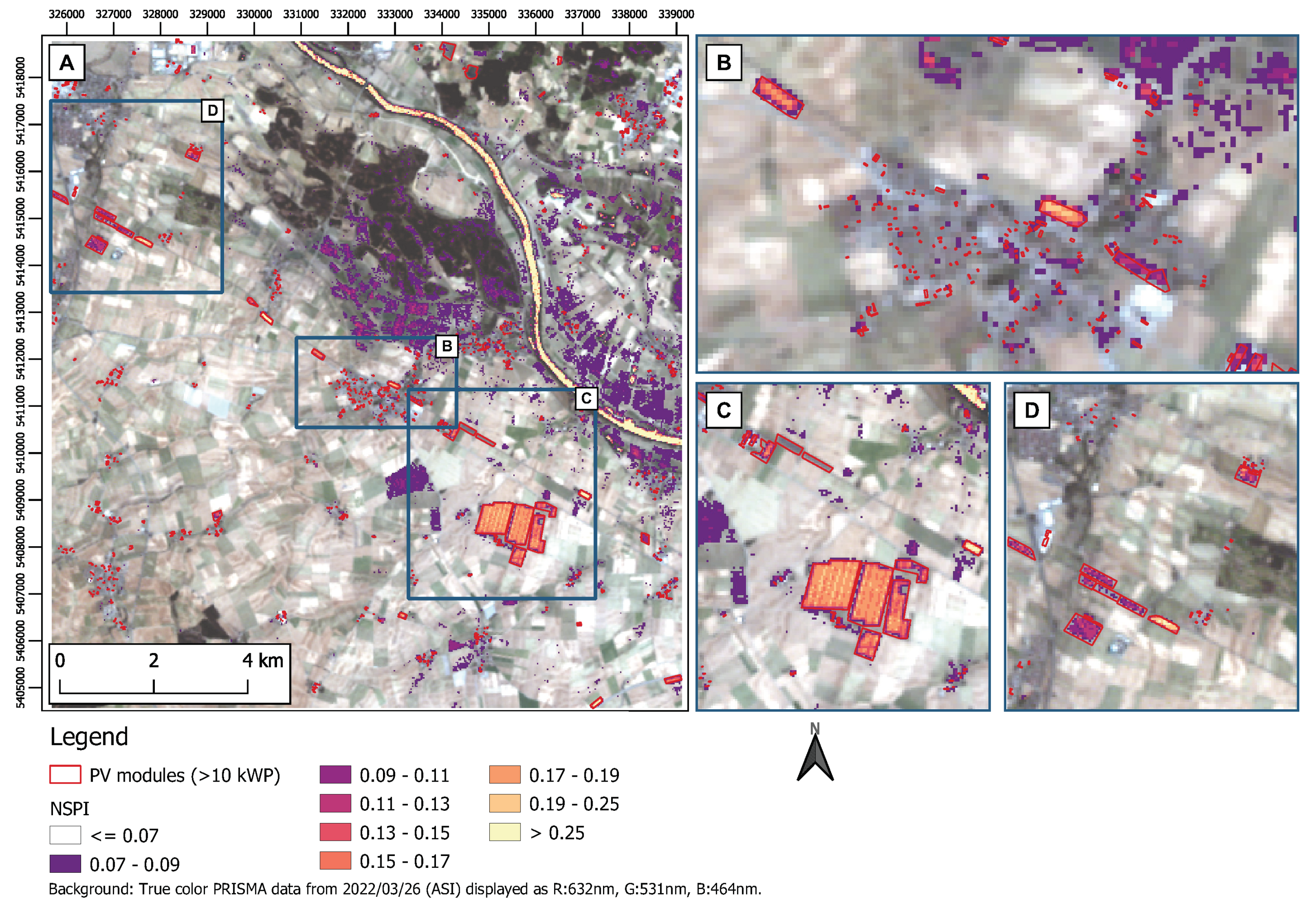
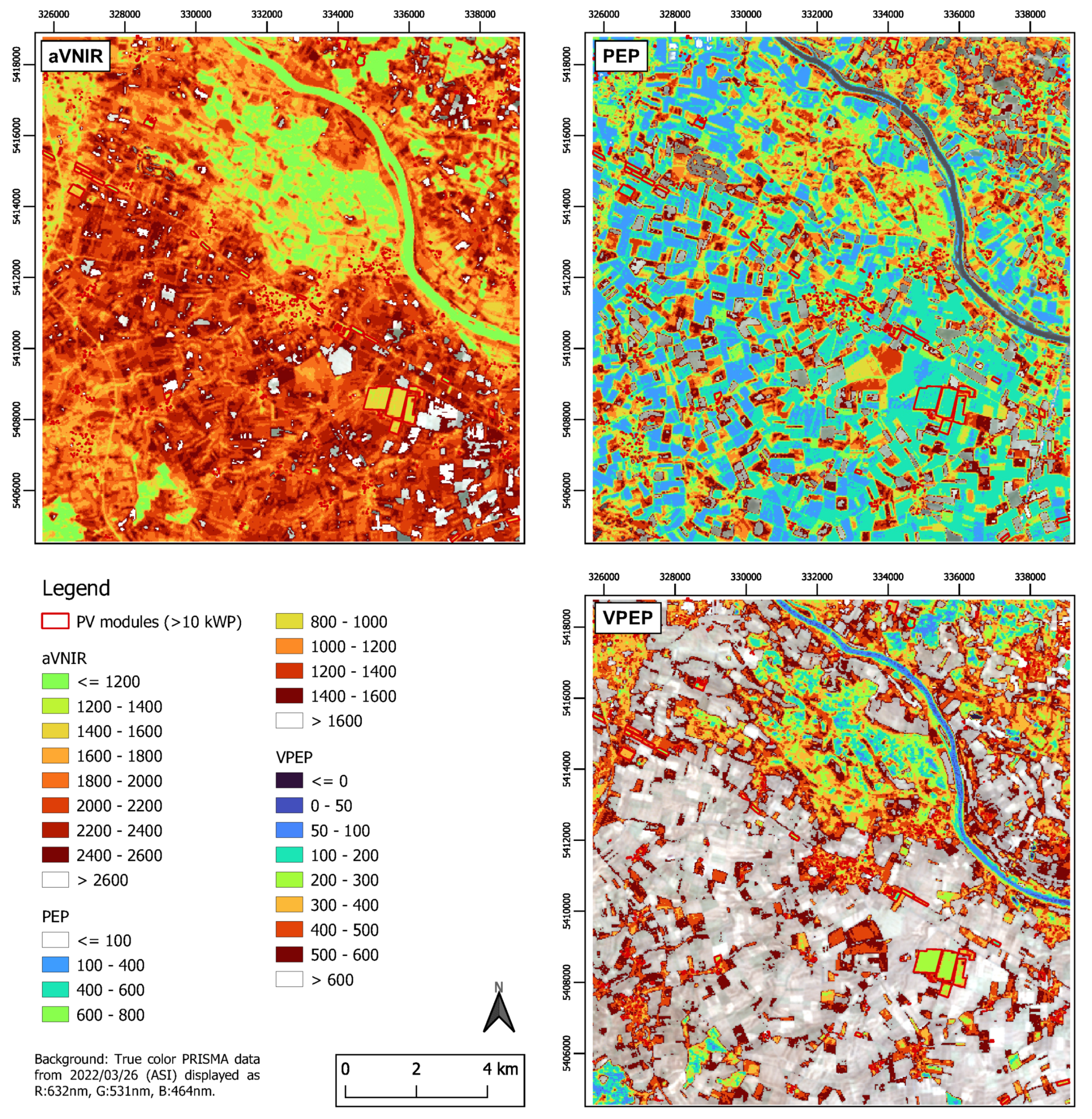

| Sensor | Grid Search | nHI | NSPI | aVNIR | PEP | VPEP | PEP min |
|---|---|---|---|---|---|---|---|
| AVIRIS-NG | start | 0.01 | 0.01 | 2000 | 100 | 100 | - |
| end | 0.12 | 0.12 | 2800 | 400 | 400 | - | |
| step size | 0.01 | 0.01 | 200 | 50 | 50 | - | |
| PRISMA | start | 0.01 | 0.01 | 2200 | 900 | 500 | 0 |
| end | 0.09 | 0.09 | 2800 | 1700 | 1400 | 150 | |
| step size | 0.01 | 0.01 | 200 | 100 | 100 | 50 |
| Aquisition | -Score [%] | Sensitivity/ User’s Accuracy [%] | Precision/ Producer’s Accuracy [%] | Overall Accuracy [%] | Specifity [%] |
|---|---|---|---|---|---|
| AVIRIS-NG | 73.40 | 65.94 | 82.77 | 99.40 | 99.83 |
| PRISMA | 78.33 | 70.53 | 88.06 | 99.56 | 99.89 |
Disclaimer/Publisher’s Note: The statements, opinions and data contained in all publications are solely those of the individual author(s) and contributor(s) and not of MDPI and/or the editor(s). MDPI and/or the editor(s) disclaim responsibility for any injury to people or property resulting from any ideas, methods, instructions or products referred to in the content. |
© 2023 by the authors. Licensee MDPI, Basel, Switzerland. This article is an open access article distributed under the terms and conditions of the Creative Commons Attribution (CC BY) license (https://creativecommons.org/licenses/by/4.0/).
Share and Cite
Jörges, C.; Vidal, H.S.; Hank, T.; Bach, H. Detection of Solar Photovoltaic Power Plants Using Satellite and Airborne Hyperspectral Imaging. Remote Sens. 2023, 15, 3403. https://doi.org/10.3390/rs15133403
Jörges C, Vidal HS, Hank T, Bach H. Detection of Solar Photovoltaic Power Plants Using Satellite and Airborne Hyperspectral Imaging. Remote Sensing. 2023; 15(13):3403. https://doi.org/10.3390/rs15133403
Chicago/Turabian StyleJörges, Christoph, Hedwig Sophie Vidal, Tobias Hank, and Heike Bach. 2023. "Detection of Solar Photovoltaic Power Plants Using Satellite and Airborne Hyperspectral Imaging" Remote Sensing 15, no. 13: 3403. https://doi.org/10.3390/rs15133403
APA StyleJörges, C., Vidal, H. S., Hank, T., & Bach, H. (2023). Detection of Solar Photovoltaic Power Plants Using Satellite and Airborne Hyperspectral Imaging. Remote Sensing, 15(13), 3403. https://doi.org/10.3390/rs15133403






